Spaceborne Satellite for Snow Cover and Hydrological Characteristic of the Gilgit River Basin, Hindukush–Karakoram Mountains, Pakistan
Abstract
1. Introduction
2. Materials and Methods
2.1. Study Area
2.2. MODIS Snow Cover
2.3. Topographic Reference
2.4. SCA and In-Situ Data
3. Results
3.1. Snow Cover Dynamics
3.2. Climatic Variability Analysis
3.3. Correlation Between Snow Dynamics, Climate Variables, and Stream Flow in the Gilgit River Basin
3.4. Hydrological Behavior of the Gilgit River Basin
4. Discussion
5. Conclusions
Author Contributions
Funding
Acknowledgments
Conflicts of Interest
References
- Soncini, A.; Bocchiola, D.; Confortola, G.; Bianchi, A.; Rosso, R.; Mayer, C. Future Hydrological Regimes in the Upper Indus Basin: A Case Study from a High-Altitude Glacierized Catchment. J. Hydrometeorol. 2015, 16, 306–326. [Google Scholar] [CrossRef]
- Immerzeel, W.W.; VanBeek, L.P.H.; Bierkens, M.F.P. Climate Change Will Affect the Asian Water Towers. Paleobiol. Sci. 2010, 328, 1382–1385. [Google Scholar] [CrossRef] [PubMed]
- SHIP. Snow and Ice Hydrology Project, Upper Indus River Basin; WAPDA-IDRC-Wilfrid Laurier University: Waterloo, ON, Canada, 1990; p. 179. [Google Scholar]
- Tahir, A.A.; Chevallier, P.; Arnaud, Y.; Neppel, L.; Ahmad, B. Modeling snowmelt-runoff under climate scenarios in the Hunza River basin, Karakoram Range, Northern Pakistan. J. Hydrol. 2011, 409, 104–117. [Google Scholar] [CrossRef]
- Akhtar, M.; Ahmad, N.; Booij, M.J. The impact of climate change on the water resources of Hindukush-Karakorum-Himalaya region under different glacier coverage scenarios. J. Hydrol. 2008, 355, 148–163. [Google Scholar] [CrossRef]
- Young, G.J.; Hewitt, K. Hydrology research in the upper Indus basin, Karakoram Himalaya, Pakistan. Hydrol. Mt. Areas. 1990, 190, 139–152. [Google Scholar]
- Hewitt, K. The Karakoram Anomaly? Glacier Expansion and the “Elevation Effect,” Karakoram Himalaya. Mt. Res. Dev. 2005, 25, 332–340. [Google Scholar] [CrossRef]
- Wipf, S.; Stoeckli, V.; Bebi, P. Winter climate change in alpine tundra: Plant responses to changes in snow depth and snowmelt timing. Clim. Chang. 2009, 94, 105–121. [Google Scholar] [CrossRef]
- Sakai, A.; Fujita, K. Contrasting glacier responses to recent climate change in high-mountain Asia. Sci. Rep. 2017, 7, 1–8. [Google Scholar] [CrossRef]
- McCarthy, J.J.; Canziani, O.F.; Leary, N.A.; Dokken, D.J.; White, K.S. Climate Change 2001: Impacts, Adaptation & Vulnerability: Contribution of Working Groupii to the Third Assessment Report of IPCC; Cambridge University Press: Cambridge, UK, 2001. [Google Scholar]
- Immerzeel, W.W.; Droogers, P.; de Jong, S.M.; Bierkens, M.F.P. Large-scale monitoring of snow cover and runoff simulation in Himalayan river basins using remote sensing. Remote Sens. Environ. 2009, 113, 40–49. [Google Scholar] [CrossRef]
- Sirguey, P.; Mathieu, R.; Arnaud, Y. Subpixel monitoring of the seasonal snow cover with MODIS at 250 m spatial resolution in the Southern Alps of New Zealand: Methodology and accuracy assessment. Remote Sens. Environ. 2009, 113, 160–181. [Google Scholar] [CrossRef]
- Lee, S.; Klein, A.G.; Over, T.M. A comparison of MODIS and NOHRSC snow-cover products for simulating streamflow using the Snowmelt Runoff Model. Hydrol. Process. 2005, 19, 2951–2972. [Google Scholar] [CrossRef]
- Tekeli, A.E.; Akyürek, Z.; Şorman, A.A.; Şensoy, A.; Şorman, A.Ü. Using MODIS snow cover maps in modeling snowmelt runoff process in the eastern part of Turkey. Remote Sens. Environ. 2005, 97, 216–230. [Google Scholar] [CrossRef]
- Scherler, D.; Bookhagen, B.; Strecker, M.R. Spatially variable response of Himalayan glaciers to climate change affected by debris cover. Nat. Geosci. 2011, 4, 156–159. [Google Scholar] [CrossRef]
- Archer, D. Contrasting hydrological regimes in the upper Indus Basin. J. Hydrol. 2003, 274, 198–210. [Google Scholar] [CrossRef]
- Fowler, H.J.; Archer, D.R. Hydro-climatological variability in the Upper Indus Basin and implications for water resources. In Proceedings of the 7th IAHS Scientific Assembly, Foz do Iguaçu, Brazil, 3–9 April 2005; Volume 295, pp. 131–138. [Google Scholar]
- Hussain, S.S.; Mudasser, M.; Munir, M. Climate change and variability in mountain regions of Pakistan Implications for water and Agriculture. Pakistan J. Meteorol. 2005, 2, 75–90. [Google Scholar]
- Water, N.; Profile, S. Pakistan Water Sector Strategy; Chairman Federal Flood Commission: Islamabad, Pakistan, 2002.
- Winiger, M.; Gumpert, M.; Yamout, H. Karakorum-Hindukush-western Himalaya: Assessing high-altitude water resources. Hydrol. Process. 2005, 19, 2329–2338. [Google Scholar] [CrossRef]
- Dong, C.; Menzel, L. Improving the accuracy of MODIS 8-day snow products with in situ temperature and precipitation data. J. Hydrol. 2016, 534, 466–477. [Google Scholar] [CrossRef]
- Dong, C.; Menzel, L. Producing cloud-free MODIS snow cover products with conditional probability interpolation and meteorological data. Remote Sens. Environ. 2016, 186, 439–451. [Google Scholar] [CrossRef]
- Riggs, G.; Hall, D.; Roman, M. MODIS snow products user guide to collection 6. Digit. Media 2016, 6, 1–66. Available online: http://scholar.google.com/scholar?hl=en&btnG=Search&q=intitle:MODIS+Snow+Products+User+Guide+to+Collection+5#0 (accessed on 5 September 2018).
- Paull, D.J.; Lees, B.G.; Thompson, J.A. An Improved Liberal Cloud-Mask for Addressing Snow/Cloud Confusion with MODIS. Photogramm. Eng. Remote Sens. 2015, 81, 119–129. [Google Scholar] [CrossRef]
- Gafurov, A.; Bárdossy, A. Cloud removal methodology from MODIS snow cover product. Hydrol. Earth Syst. Sci. 2009, 13, 1361–1373. [Google Scholar] [CrossRef]
- Muster, S.; Langer, M.; Abnizova, A.; Young, K.L.; Boike, J. Spatio-temporal sensitivity of MODIS land surface temperature anomalies indicates high potential for large-scale land cover change detection in Arctic permafrost landscapes. Remote Sens. Environ. 2015, 168, 1–12. [Google Scholar] [CrossRef]
- Hess, A.; Iyer, H.; Malm, W. Linear trend analysis: A comparison of methods. Atmos. Environ. 2001, 35, 5211–5222. [Google Scholar] [CrossRef]
- Khan, A.; Richards, K.S.; Parker, G.T.; McRobie, A.; Mukhopadhyay, B. How large is the Upper Indus Basin? The pitfalls of auto-delineation using DEMs. J. Hydrol. 2014, 509, 442–453. [Google Scholar] [CrossRef]
- Moore, S. Climate change, water and China’s national interest. China Secur. 2009, 5, 25–39. [Google Scholar]
- Farhan, S.B.; Zhang, Y.; Ma, Y.; Gao, H.; Rehmatullah, J. The magnitude and seasonal stream flow fluctuations of Hunza River, Karakoram region during 1966–2010. In Proceedings of the EGU General Assembly 2014, Vienna, Austria, 27 April–2 May 2014; Volume 16, p. 4768. [Google Scholar]
- Rasul, G.; Chaudhry, Q.Z.; Mahmood, A.; Hyder, K.W.; Dahe, Q. Glaciers and Glacial Lakes under Changing Climate in Pakistan. Pak. J. Meteorol. 2011, 8, 1–8. [Google Scholar]
- Bates, B.C.; Kundzewicz, Z.W.; Wu, S.; Palutikof, J.P. Climate Change and Water Climate Change and Water. 2008, p. 210. Available online: http://www.citeulike.org/group/14742/article/8861411%5Cnhttp://www.ipcc.ch/publications_and_data/publications_and_data_technical_papers.shtml#.UREVW6X7Uy4 (accessed on 23 October 2018).
- Shrestha, A.B.; Agrawal, N.K.; Alfthan, B.; Bajracharya, S.R.; Maréchal, J.; vanOort, B. The Himalayan Climate and Water Atlas. 2015, p. 100. Available online: http://www.grida.no/publications/69 (accessed on 23 October 2018).
- Lhamo, S. Assessment of Runoff Regime in Wang Chhu River Basin, Bhutan By Snow Cover Mapping and Stream Flow Modelling. 2015. Available online: https://www.itc.nl/library/papers_2015/msc/wrem/lhamo.pdf (accessed on 7 August 2018).
- Sharif, M.; Archer, D.R.; Fowler, H.J.; Forsythe, N. Trends in timing and magnitude of flow in the Upper Indus Basin. Hydrol. Earth Syst. Sci. 2013, 17, 1503–1516. [Google Scholar] [CrossRef]
- Tahir, A.A.; Chevallier, P.; Arnaud, Y.; Ashraf, M.; Bhatti, M.T. Snow cover trend and hydrological characteristics of the Astore River basin (Western Himalayas) and its comparison to the Hunza basin (Karakoram region). Sci. Total Environ. 2015, 505, 748–761. [Google Scholar] [CrossRef]
- Jianchu, X.; Shrestha, A.; Eriksson, M. Climate Change and Its Impacts on Glaciers and Water Resource Management in the Himalayan Region. Assessment of Snow, Glacier and Water Resources in Asia. 2009, pp. 43–54. Available online: http://www.mtnforum.org/sites/default/files/publication/files/5412.pdf (accessed on 3 October 2018).
- Forsythe, N.; Kilsby, C.G.; Fowler, H.J.; Archer, D.R. Assessment of Runoff Sensitivity in the Upper Indus Basin to Interannual Climate Variability and Potential Change Using MODIS Satellite Data Products. Mt. Res. Dev. 2012, 32, 16–29. [Google Scholar] [CrossRef]
- Forland, E.J.; Hanssen-bauer, I. Increased precipitation in the Norwegian Arctic:True or false? Clim. Chang. 2000, 46, 485–509. [Google Scholar] [CrossRef]
- Wake, C.P. Spatial and Temporal Variation of Snow Accumulation in the Central Karakoram, Northern Pakistan. Master Thesis, Wilfrid Laurier University, Waterloo, ON, Canada, 1987. [Google Scholar]
- Sevruk, B. Correction of Precipitation Measurement, Workshop on the Correction of Precipitation Measurement, Zurich, Switcherland; International Association of Hydrological Science: Wallingford, UK, 1985; pp. 13–23. [Google Scholar]
- Sevruk, B. Reliability of Precipitation Measurement, International Workshop on Precipitation Measurement. 1989, pp. 13–19. Available online: https://www.scirp.org/(S(i43dyn45teexjx455qlt3d2q))/reference/ReferencesPapers.aspx?ReferenceID=1073013 (accessed on 15 August 2018).
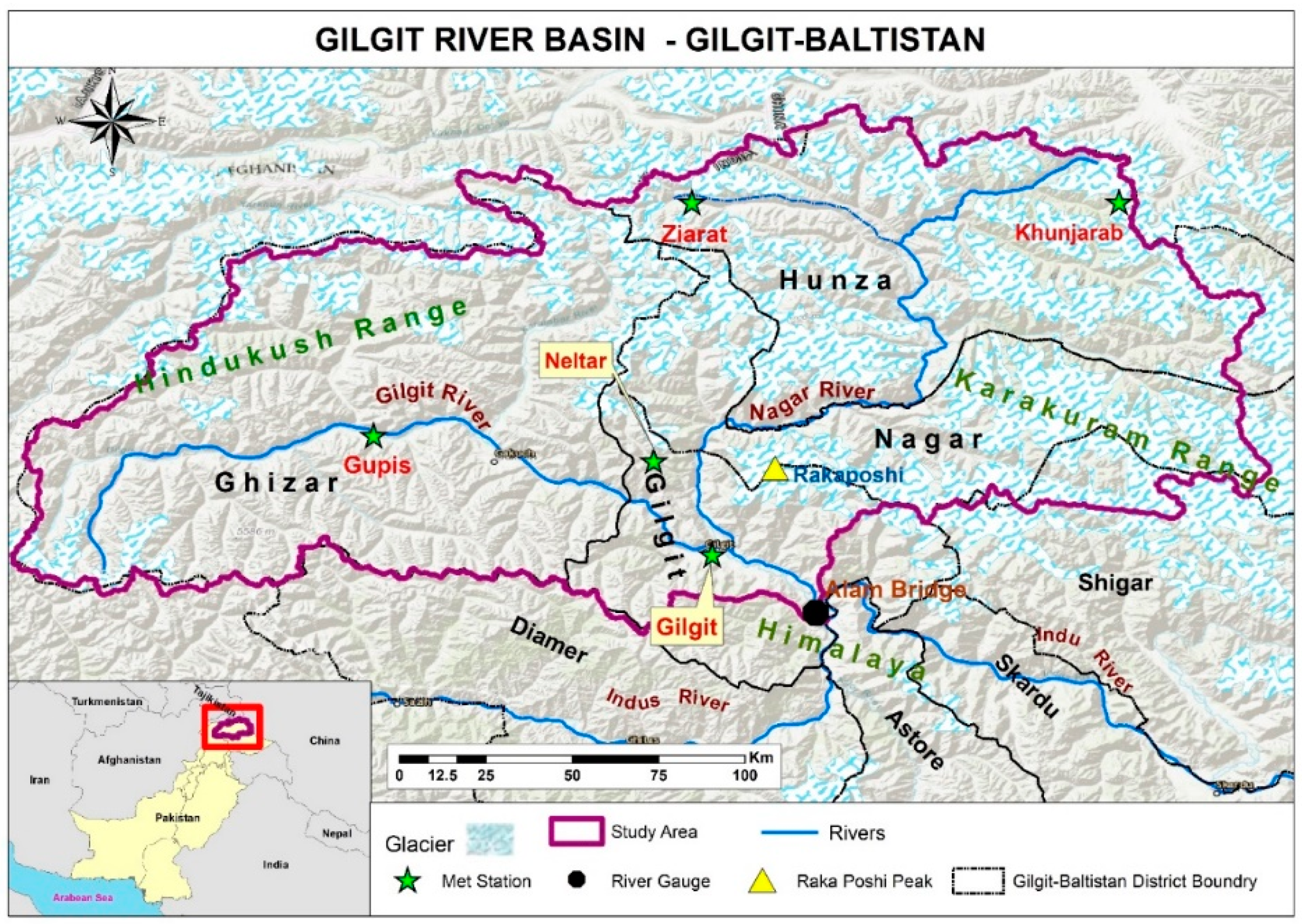
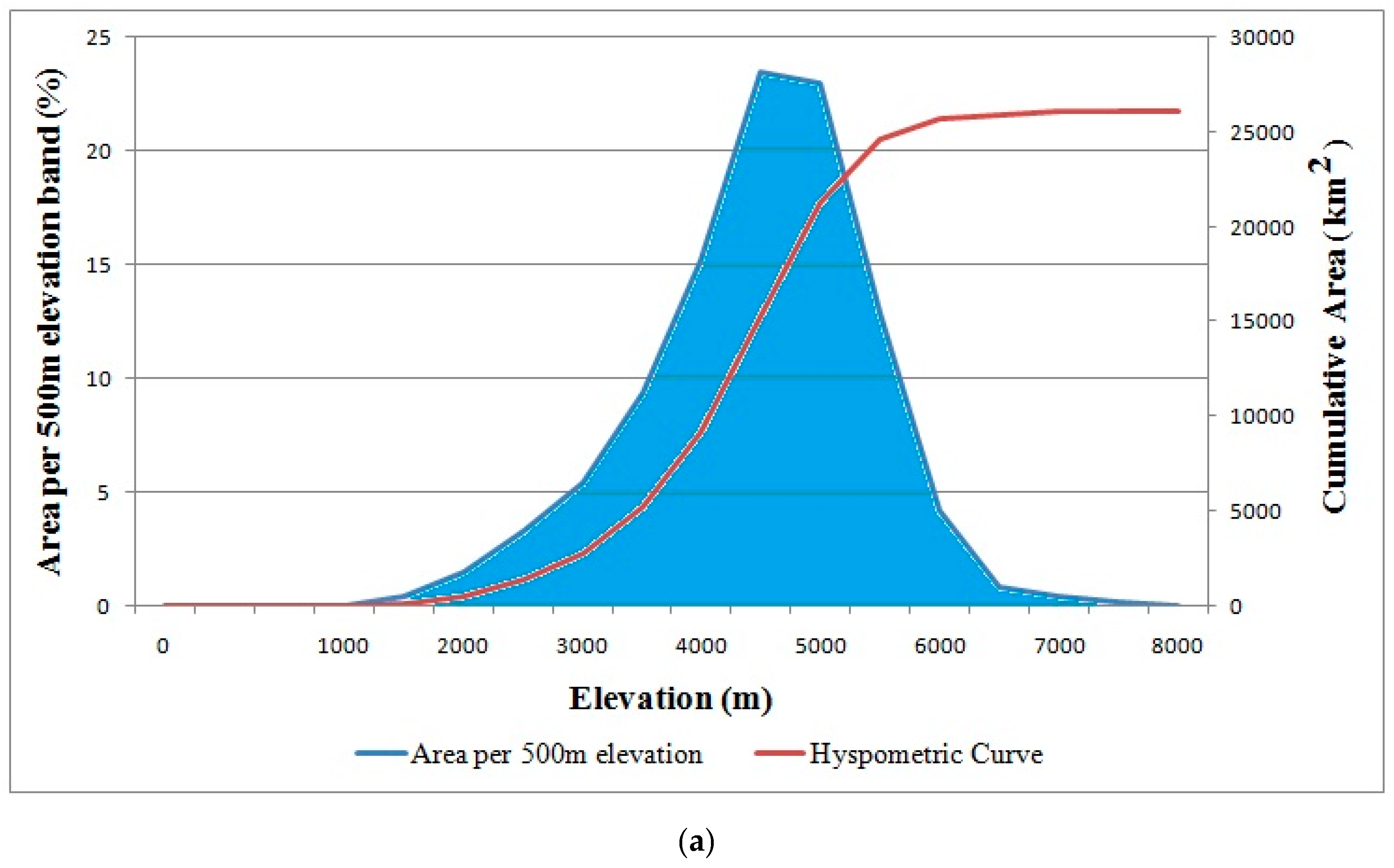
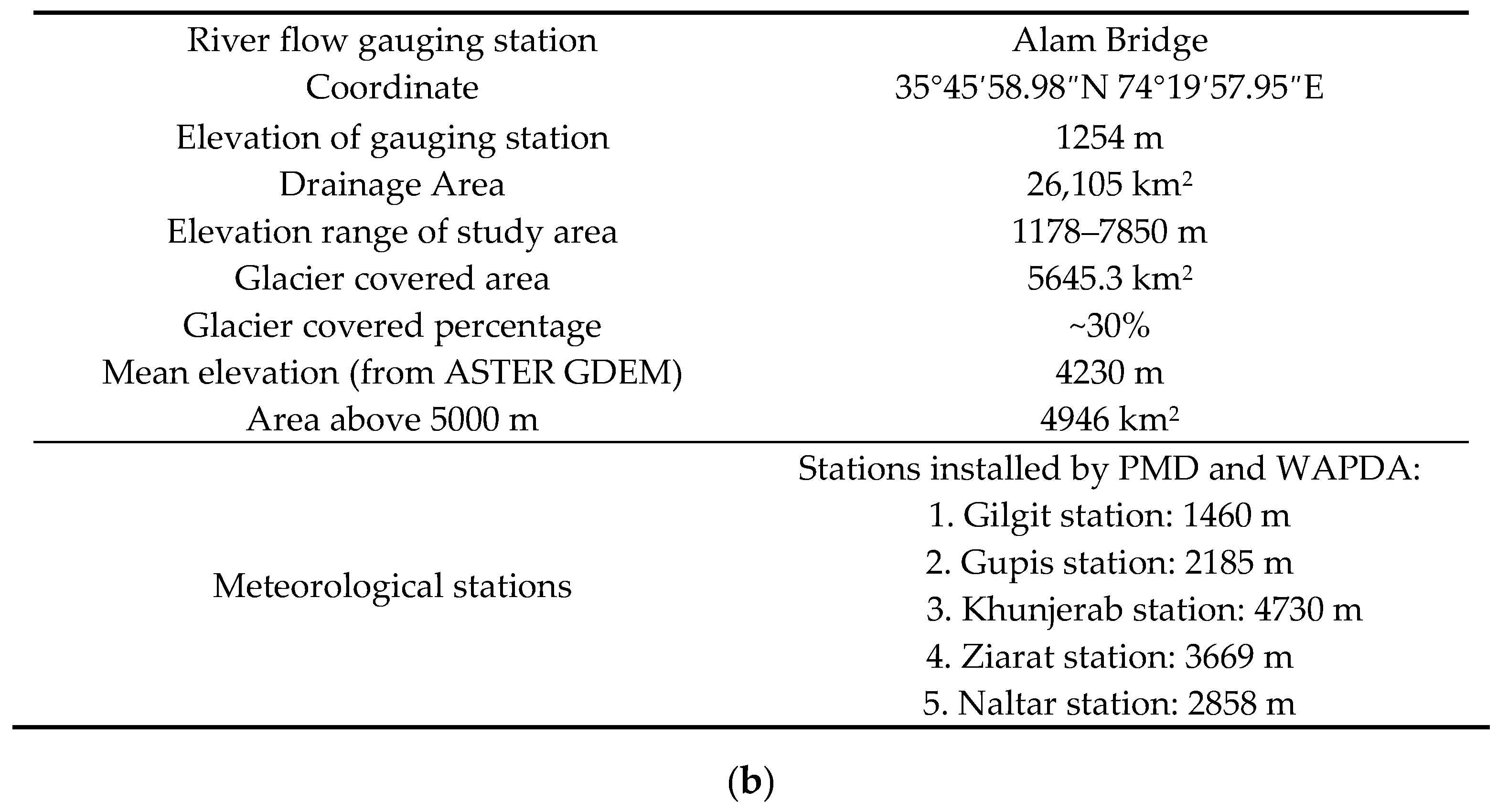
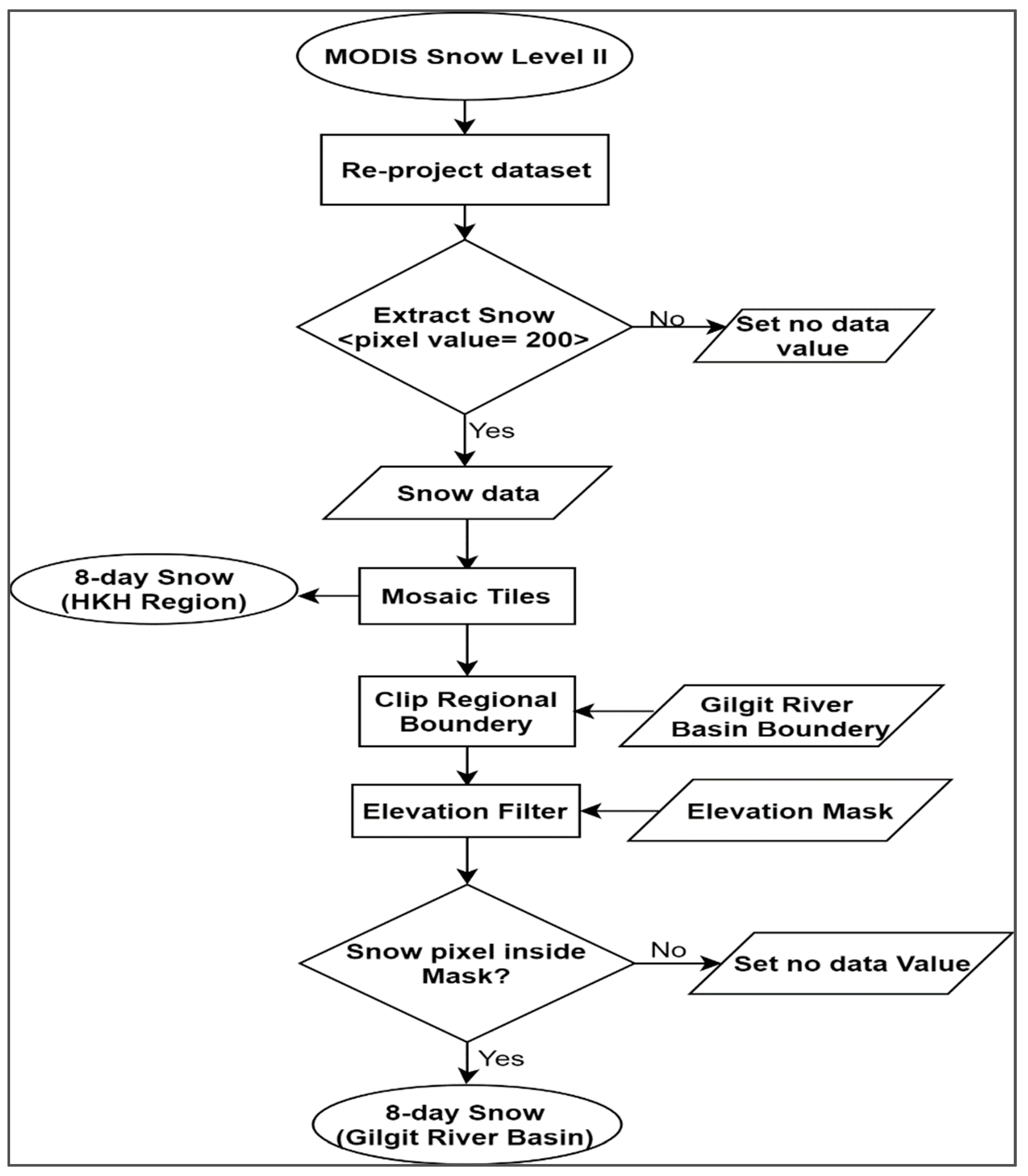
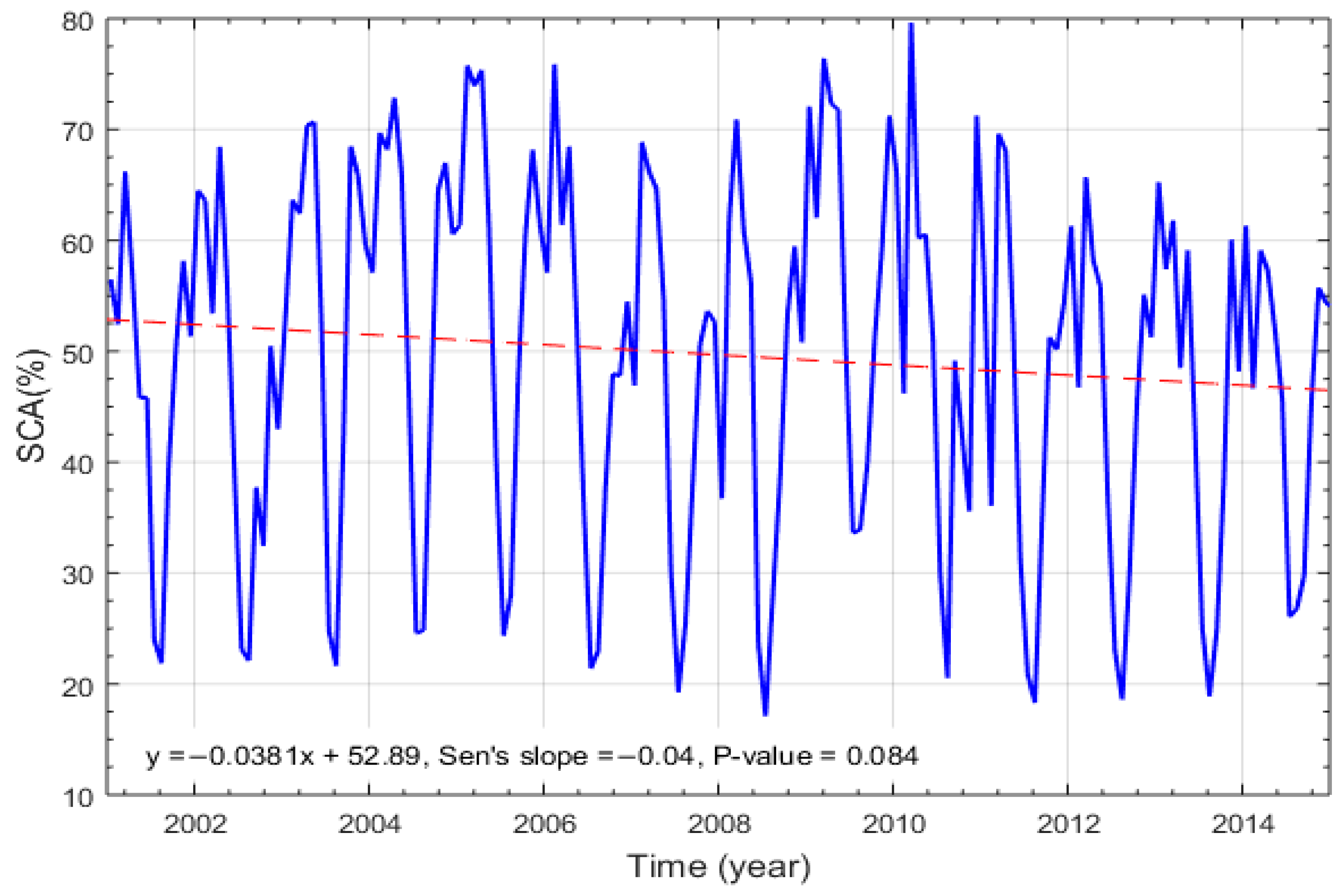
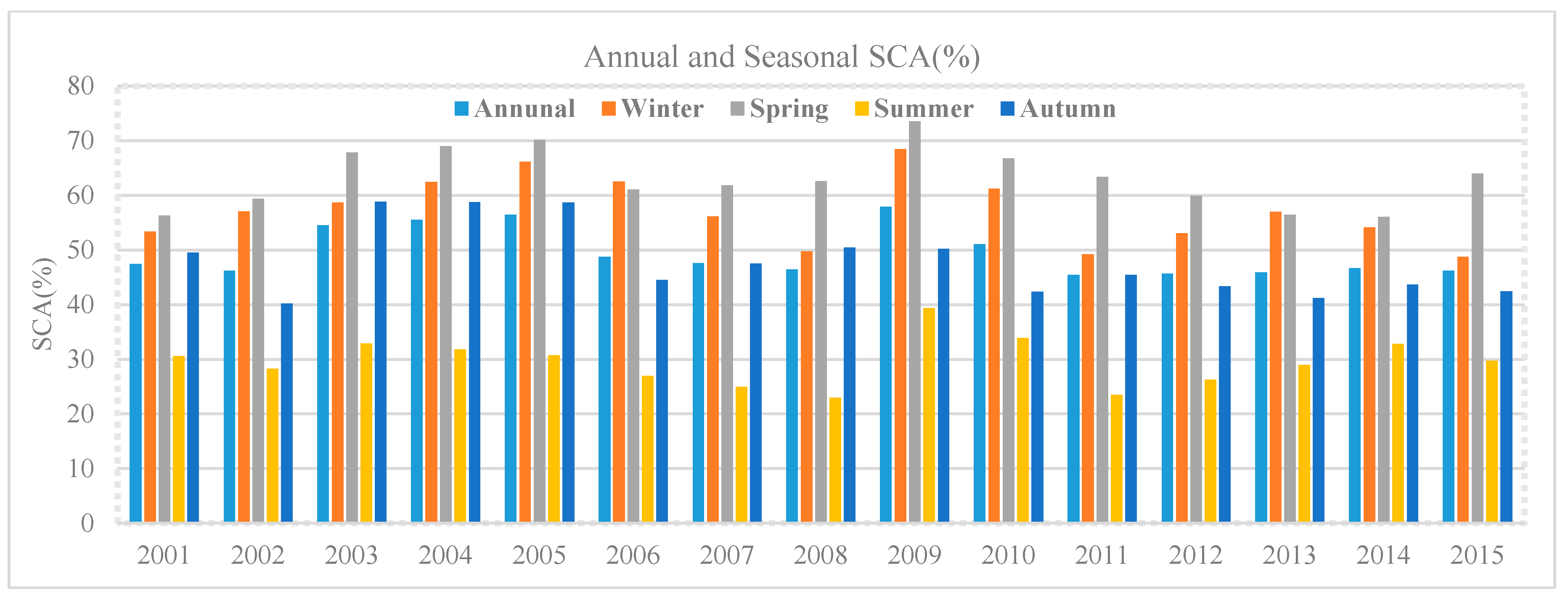
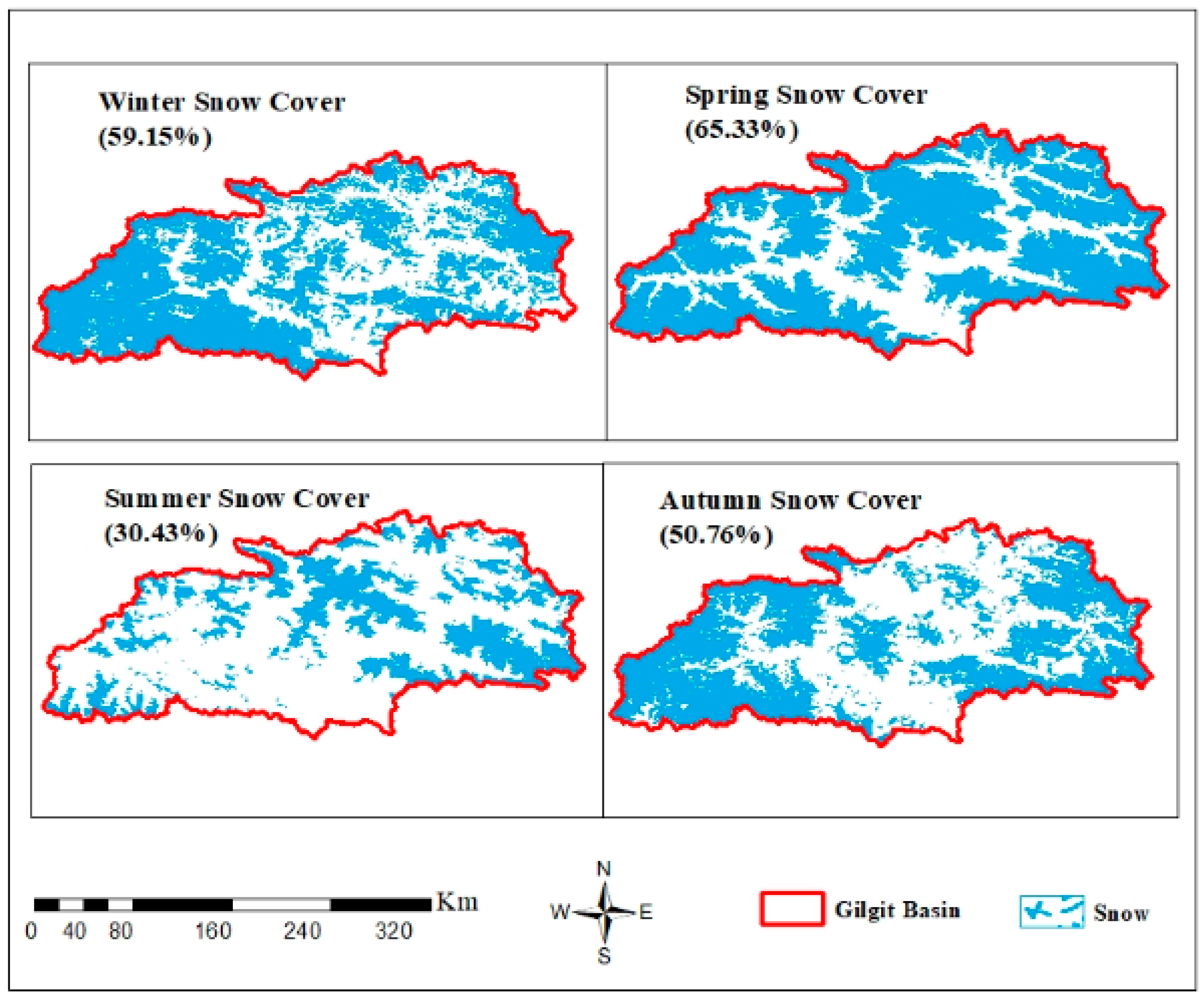
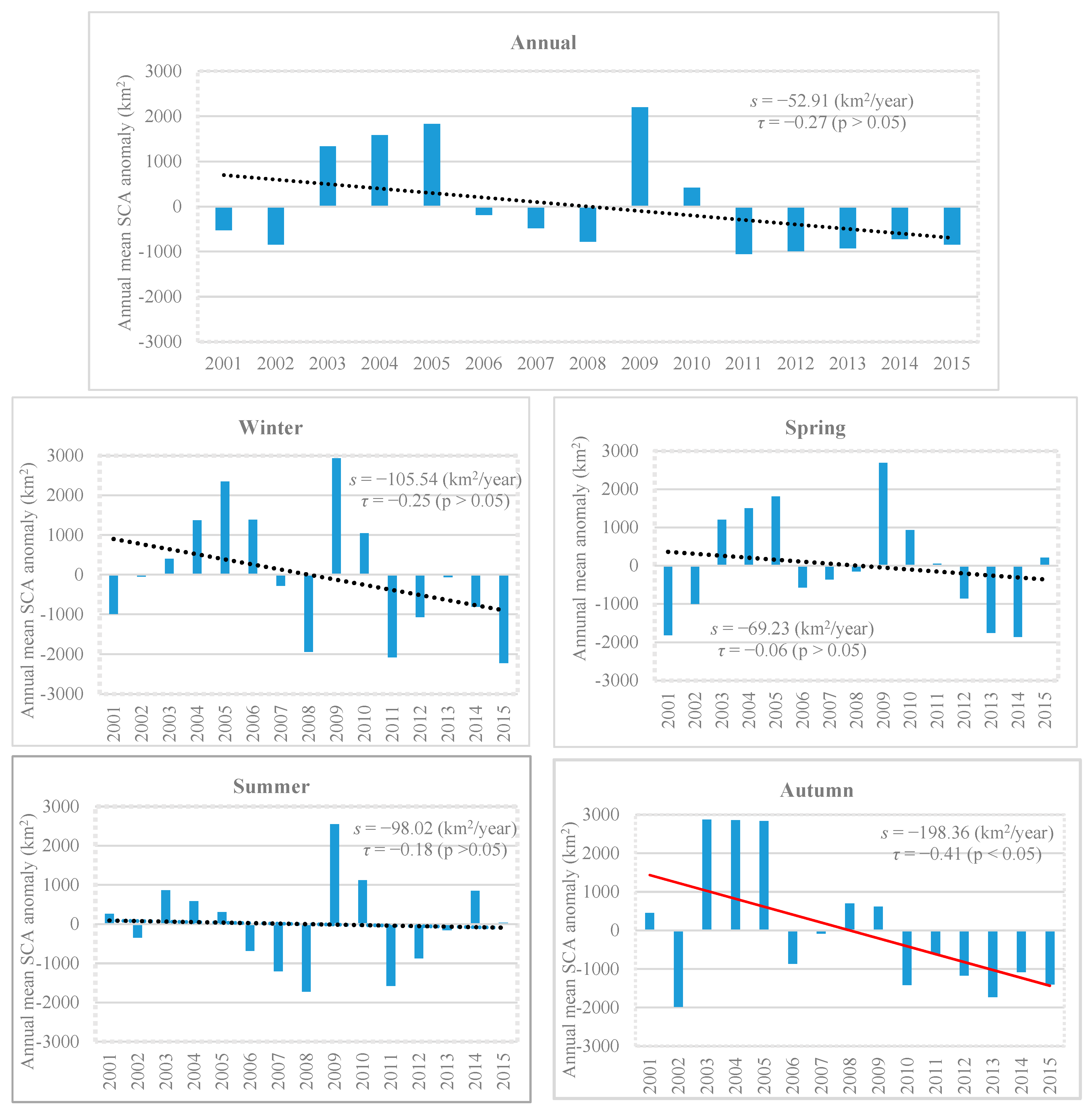

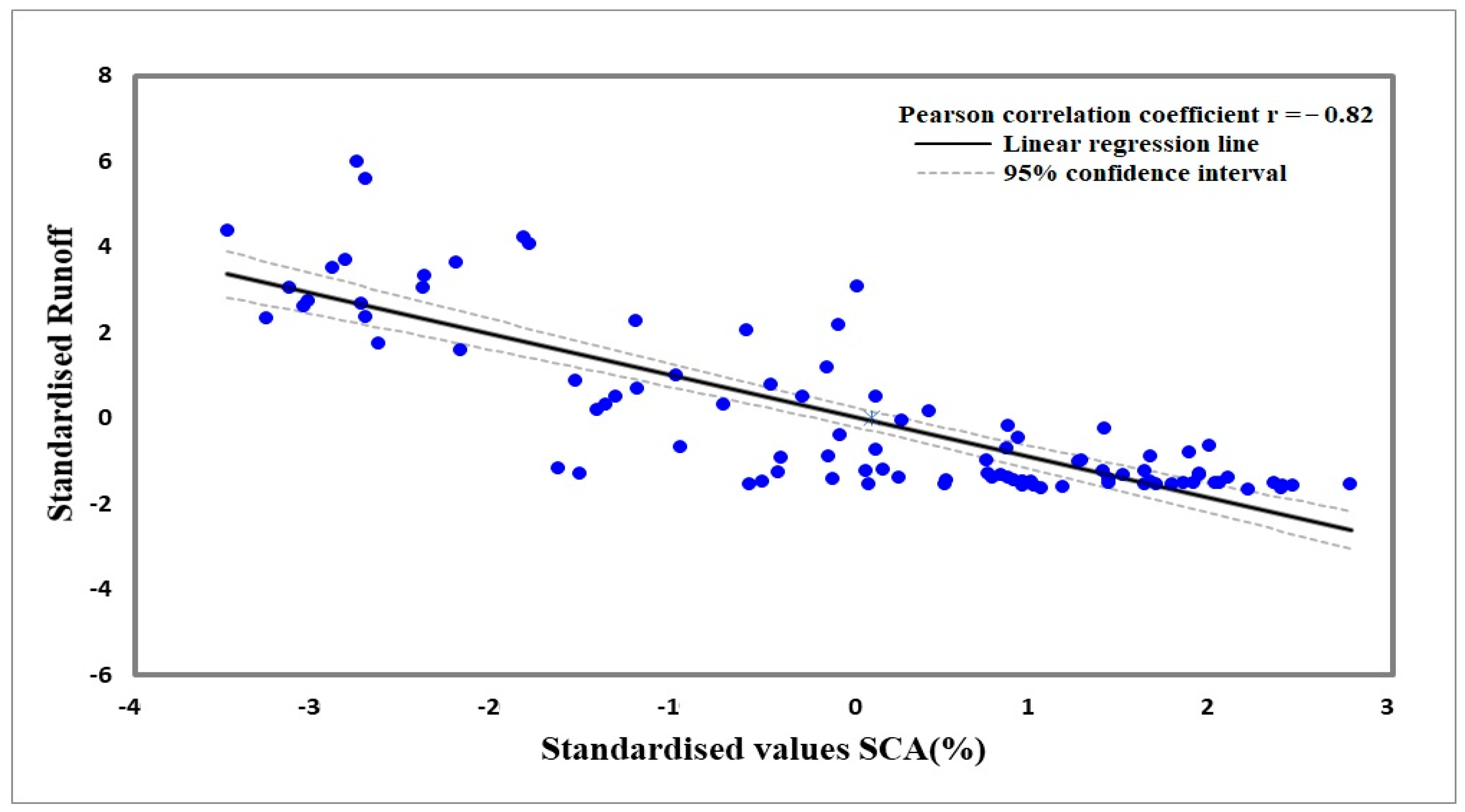
| Observatory | Gupis | Khunjerab | Ziarat | Naltar | ||||||||||||
|---|---|---|---|---|---|---|---|---|---|---|---|---|---|---|---|---|
| Tmax * | Tmin ** | Tmean *** | Prec. **** | Tmax | Tmin | Tmean | Prec. | Tmax | Tmin | Tmean | Prec. | Tmax | Tmin | Tmean | Prec. | |
| Gilgit | 0.993 | 0.956 | 0.968 | 0.624 | 0.984 | 0.941 | 0.981 | 0.168 | 0.977 | 0.956 | 0.982 | 0.207 | 0.987 | 0.863 | 0.962 | 0.512 |
| Gupis | - | - | - | - | 0.984 | 0.953 | 0.966 | 0.139 | 0.977 | 0.977 | 0.970 | 0.256 | 0.986 | 0.902 | 0.951 | 0.465 |
| Khunjerab | - | - | - | - | - | - | - | - | 0.984 | 0.971 | 0.986 | 0.412 | 0.987 | 0.816 | 0.945 | 0.364 |
| Ziarat | - | - | - | - | - | - | - | - | - | - | - | - | 0.985 | 0.892 | 0.964 | 0.307 |
| Coefficient values were determined by using Pearson’s correlation with 95% confidence interval at p = 0.05 | ||||||||||||||||
| Observatory | Climatic Variables | M-K | P | Sen’s Slope | Trend |
|---|---|---|---|---|---|
| Gilgit | Annual T (Jan.–Dec.) | 0.27 | 0.13 | 0.02 | [+, *] |
| Summer T (Apr.–Sep.) | 0.11 | 0.57 | 0.02 | [+, *] | |
| Winter T (Oct.–Mar.) | 0.29 | 0.09 | 0.05 | [+, *] | |
| Precipitation (Jan.–Dec.) | −0.06 | 0.76 | −1.9 | [−, *] | |
| Gupis | Annual T (Jan.–Dec.) | 0.05 | 0.82 | 0.02 | [+, *] |
| Summer T (Apr.–Sep.) | 0.12 | 0.52 | 0.04 | [+, *] | |
| Winter T (Oct.–Mar.) | 0.11 | 0.54 | 0.01 | [+, *] | |
| Precipitation (Jan.–Dec.) | −0.19 | 0.29 | −9.56 | [−, *] | |
| Khunjerab | Annual T (Jan.–Dec.) | 0.24 | 0.17 | 0.05 | [+, *] |
| Summer T (Apr.–Sep.) | 0.18 | 0.59 | 0.02 | [+, *] | |
| Winter T (Oct.–Mar.) | 0.27 | 0.13 | 0.17 | [+, *] | |
| Precipitation (Jan.–Dec.) | 0.12 | 0.49 | 2.75 | [+, *] | |
| Ziarat | Annual T (Jan.–Dec.) | 0.15 | 0.41 | 0.03 | [+, *] |
| Summer T (Apr.–Sep.) | −0.08 | 0.65 | −0.01 | [−, * ] | |
| Winter T (Oct.–Mar.) | 0.24 | 0.17 | 0.05 | [+, *] | |
| Precipitation (Jan.–Dec.) | 0.24 | 0.17 | 7.3 | [+, *] | |
| Naltar | Annual T (Jan.–Dec.) | −0.29 | 0.11 | −0.06 | [−, * ] |
| Summer T (Apr.–Sep.) | −0.33 | 0.06 | −0.09 | [−, * ] | |
| Winter T (Oct.–Mar.) | −0.20 | 0.26 | −0.08 | [−, * ] | |
| Precipitation (Jan.–Dec.) | 0.23 | 0.19 | 14.98 | [+, *] |
| Climate Data | Snow Cover Dynamics in Gilgit River Basin | |||
|---|---|---|---|---|
| Annual Correlation (Jan. to Dec.) | Summer Correlation (Apr. to Sep.) | Winter Correlation (Oct. to Mar.) | ||
| a. Mean Temperature | ||||
| Gilgit | −0.612 | −0.834 | 0.049 (0.66) | |
| Gupis | −0.626 | −0.822 | −0.025 (0.83) | |
| Khunjerab | −0.662 | −0.832 | −0.078 (0.49) | |
| Ziarat | −0.683 | −0.892 | −0.101 (0.38) | |
| Naltar | −0.635 | −0.783 | 0.010 (0.93) | |
| Avg. of Gilgit Basin | −0.652 | −0.873 | −0.027 (0.81) | |
| Precipitation | ||||
| Gilgit | 0.001(0.99) | 0.248 | 0.179 (0.12) | |
| Gupis | 0.093(0.25) | 0.252 | 0.233 | |
| Khunjerab | −0.124(0.122) | −0.274 | 0.072 (0.53) | |
| Ziarat | 0.121(0.13) | 0.079 (0.48) | 0.205 (0.71) | |
| Naltar | 0.060(0.38) | 0.246 | −0.047 (0.68) | |
| Avg. of Gilgit Basin | 0.076(0.34) | 0.248 | 0.119 (0.29) | |
| b. Stream flow | −0.806 | −0.836 | −0.415 | |
| Summer Stream flow | - | - | 0.063 (0.57) | |
| Coefficient values were determined by using Pearson’s correlation with 95% confidence interval at p = 0.05 | ||||
| Observatory | Climate Variables | Stream Flow in Gilgit River at Alam Bridge | |||
|---|---|---|---|---|---|
| Annual Correlation (Jan. to Dec.) | Summer Correlation (Apr. to Sep.) | Winter Correlation (Oct. to Mar.) | |||
| Gilgit | Temperature | Minimum | 0.811 | 0.906 | 0.377 |
| Maximum | 0.797 | 0.850 | 0.623 | ||
| Mean | 0.815 | 0.914 | 0.554 | ||
| Precipitation | 0.132 (0.10) | −0.195 (0.08) | −0.254 | ||
| Gupis | Temperature | Minimum | 0.810 | 0.890 | 0.482 |
| Maximum | 0.800 | 0.845 | 0.653 | ||
| Mean | 0.810 | 0.882 | 0.588 | ||
| Precipitation | −0.009 (0.91) | −0.238 | −0.161 (0.15) | ||
| Khunjerab | Temperature | Minimum | 0.837 | 0.830 | 0.666 |
| Maximum | 0.820 | 0.890 | 0.581 | ||
| Mean | 0.836 | 0.884 | 0.640 | ||
| Precipitation | 0.174 | 0.148 (0.19) | 0.075 (0.52) | ||
| Ziarat | Temperature | Minimum | 0.845 | 0.913 | 0.614 |
| Maximum | 0.840 | 0.899 | 0.583 | ||
| Mean | 0.846 | 0.909 | 0.612 | ||
| Precipitation | −0.062 (0.44) | −0.101 (0.37) | −0.054 (0.64) | ||
| Naltar | Temperature | Minimum | 0.685 | 0.529 | 0.283 |
| Maximum | 0.836 | 0.882 | 0.611 | ||
| Mean | 0.784 | 0.750 | 0.459 | ||
| Precipitation | −0.020 (0.80) | −0.130 (0.25) | −0.092 (0.42) | ||
| Avg. Gilgit Basin | Temperature | Mean Temperature | 0.829 | 0.907 | 0.591 |
| Precipitation | Total Precipitation | 0.028 (0.073) | −0.207 (0.06) | −0.112 (0.32) | |
| Precipitation Winter (Oct. to Mar.) | Summer Correlation (Apr. to Sep.) | ||||
| Gilgit | 0.189 (0.09) | ||||
| Gupis | 0.139 (0.22) | ||||
| Khunjerab | 0.294 | ||||
| Ziarat | 0.260 | ||||
| Naltar | 0.258 | ||||
| Avg. of Gilgit Basin | 0.362 | ||||
| Coefficient values were determined by using Pearson’s correlation with 95% confidence interval at p = 0.05 | |||||
© 2019 by the authors. Licensee MDPI, Basel, Switzerland. This article is an open access article distributed under the terms and conditions of the Creative Commons Attribution (CC BY) license (http://creativecommons.org/licenses/by/4.0/).
Share and Cite
Hussain, D.; Kuo, C.-Y.; Hameed, A.; Tseng, K.-H.; Jan, B.; Abbas, N.; Kao, H.-C.; Lan, W.-H.; Imani, M. Spaceborne Satellite for Snow Cover and Hydrological Characteristic of the Gilgit River Basin, Hindukush–Karakoram Mountains, Pakistan. Sensors 2019, 19, 531. https://doi.org/10.3390/s19030531
Hussain D, Kuo C-Y, Hameed A, Tseng K-H, Jan B, Abbas N, Kao H-C, Lan W-H, Imani M. Spaceborne Satellite for Snow Cover and Hydrological Characteristic of the Gilgit River Basin, Hindukush–Karakoram Mountains, Pakistan. Sensors. 2019; 19(3):531. https://doi.org/10.3390/s19030531
Chicago/Turabian StyleHussain, Dostdar, Chung-Yen Kuo, Abdul Hameed, Kuo-Hsin Tseng, Bulbul Jan, Nasir Abbas, Huan-Chin Kao, Wen-Hau Lan, and Moslem Imani. 2019. "Spaceborne Satellite for Snow Cover and Hydrological Characteristic of the Gilgit River Basin, Hindukush–Karakoram Mountains, Pakistan" Sensors 19, no. 3: 531. https://doi.org/10.3390/s19030531
APA StyleHussain, D., Kuo, C.-Y., Hameed, A., Tseng, K.-H., Jan, B., Abbas, N., Kao, H.-C., Lan, W.-H., & Imani, M. (2019). Spaceborne Satellite for Snow Cover and Hydrological Characteristic of the Gilgit River Basin, Hindukush–Karakoram Mountains, Pakistan. Sensors, 19(3), 531. https://doi.org/10.3390/s19030531







